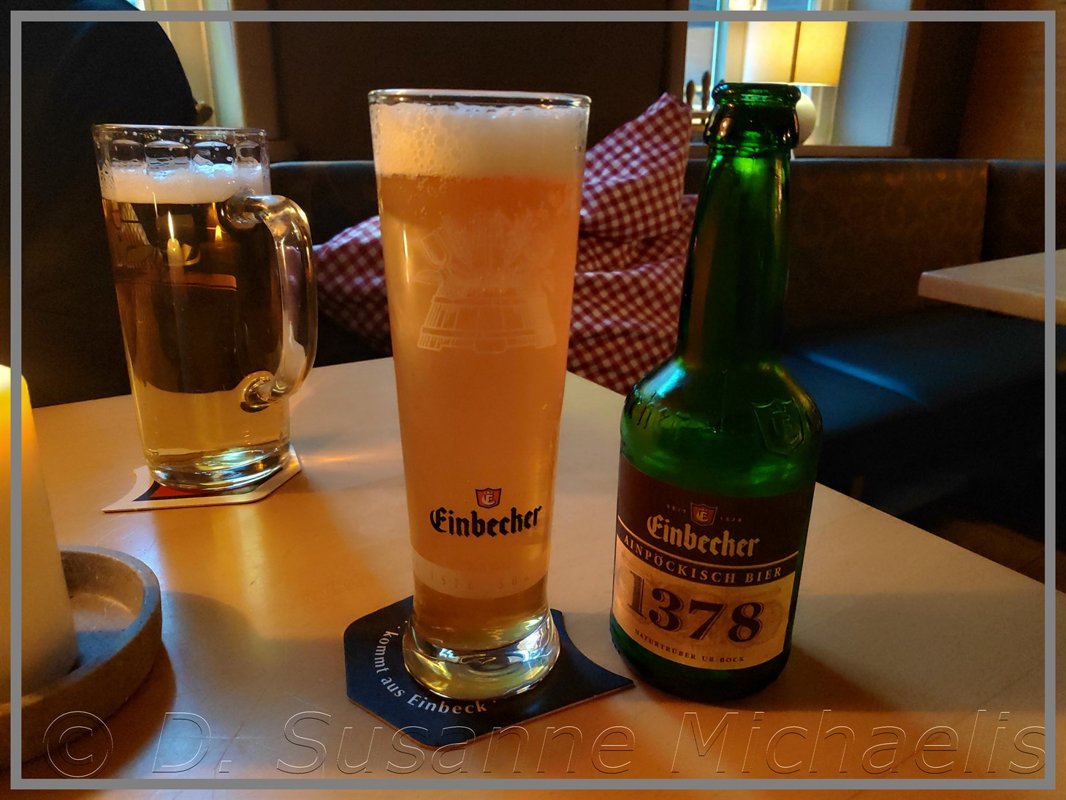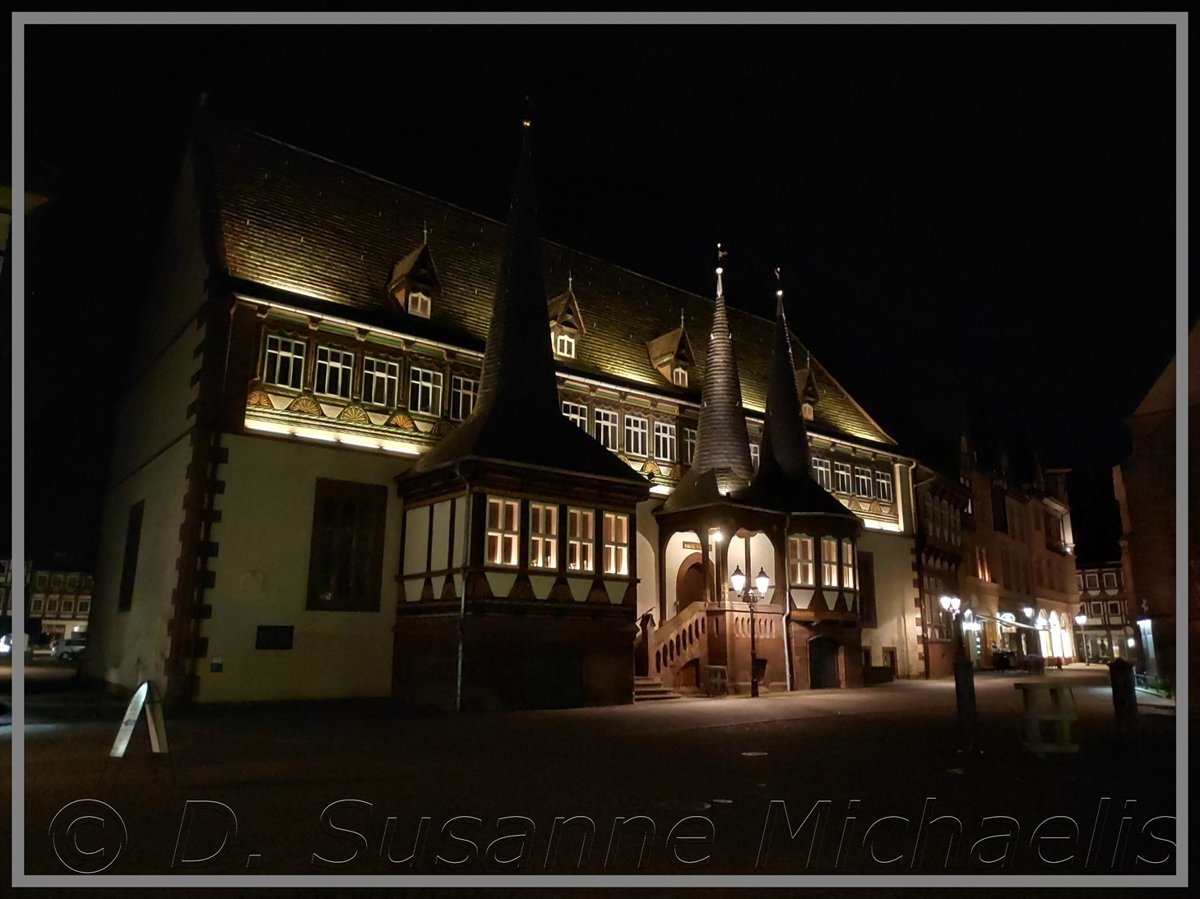Einbeck - Between beer and surprises
In 1252, Einbeck already had town ordinances and privileges, but a place called Einbeck had been there for at least a hundred years longer.
In the middle of the 14th cenrury the first exports of the Einbecker beer are documented. The beer got brewed in more than 700 (!) private homes that got a beer brewing licence (those houses are marked by their large doors for the brewing kettles) and then put onto the market by the town council. In 1368 Einbeck joined the Hansa and now their beer could be found from Antwerp (in the west of Belgium) to Riga (Latvia), from Stockholm (Sweden) to Munich (southern Germany).
To transport the top-fermented beer without it spoiling, they brewed it with an unsually high wort and a resulting higher alcohol percentage than normal beer (somewhere between 6.3 and 7.2 %).

1614, an Einbecker master brewer was hired in Munich to brew the famous Ainpöcksch beer in Munich. Legend says that the Bavarians' dialect turned Ainpöck (or Einbeck) into "Oanpock," which in turn became today's known term "ein Bock" (a billy goat" or a Bockbier (a bock beer). In other words, the Einbecker beer is the mother of all bock beers. And rightly so! When given a mug of Ainpökisch beer in 1521 in Worms, Martin Luther is quoted to have said:
Der beste Trank, den einer kennt, der wird Einbecker Bier genennt
(The best known drink is called Einbecker beer)
Einbeck wasn't just known for its beer but also for its blue-printing. According to Wikipedia.de, the first German blue-printing was done in 1689 or 1690 by Jeremias Neuhofer in Augsburg. And according to their shop webpage, the Einbecker dye factory of Hans Wittram started to use the then modern technic of blue-printing already in 1700. From 1638 til 2005, this dye factory had been without break in the hand of the family Wittram...

... and til today the blue-printing is traditionally done by hand and with the help of a treasure of over 800 models, used for the Reservedruckverfahren (an indirectly dying technique, where with the help of a wooden model a sort of paste is stamped onto the cloth before dying it. Afterwards, when washing off the paste, a white, undyed pattern will emerge). The oldest model being from around 1720/30.
Another, although more modern Einbecker highlight is the PS-Speicher, a transport museum located in a former granary with the world's largest collection of German motorcycles as well as vintage cars! It also houses the oldest vintage car in running and original condition of the world, a Victoria-Benz-Motorkutsche from 1894! It is only allowed to be driven from sunrise to sunset, but it did get this year's Vehicle inspection sticker.
But what makes Einbeck even more fascinating to me is its architecture. 1540 had been a very dry summer - and one of religious-political "gunpowder" as well. Einbeck had joined the pro-Lutheran Schmalkaldic League in 1531 and when a fire started at several different points in Einbeck simultaneously, arson was seen as being the obvious reason. In 1540 a total of 33 German cities burnt and of these fires many were suspected to be the torching of protestant cities. However, Henry V, Duke of Brunswick-Lüneburg, one of the adversaries of the League, pointed out in his written defense to the emperor that not only protestant cities had burnt.
In any case, being almost completely destroyed by the large fire in 1540, the city had to be rebuild. Thanks to its wealth it was not only rebuilt fast, but also in splendor, like the houses in the Tiedexer street demonstrate.

With many of them showing symbols of their owner's trade...

... or just its owner's sense of beauty, wealth, education and piety (as can be seen by the Latin quote):

As you can see, the letters are Antiqua-Kapitalis letters, which were used from the 16th century on. Before that date, inscriptions on half-timbered houses, starting in the second half of the 15th century, used the Gothic Minuskel, as you can (barely) see to the left and the right of the word "Brodhaus" ("Breadhouse") of this only preserved guild house from originally at least 1333 (although it had to be rebuilt after the fire as well):

However, Latin wasn't mandatory. Some just used good ole German for their inscriptions:
Besides the inscriptions and trade symbols, Taubänder ("hawser bands") were a favorite way to decorate those houses as well as rosettes, which call to mind the classical shell portrayal of the Romans as well as that of sun wheels. Not to mention the treasure of braces...

... and friezes:
Every once in a while a house sports a Neidkopf (Envy Head) of which some say it is supposed to keep off grudgers, while others claim them to be purely ornamental items:
And the Einbecker town hall even has oriels:

However, the Late Renaissance Eickesches Haus (today's tourist information), built around 1612, easily tops them all. Motives deriving from the educational world of the Humanism, Renaissance, Reformation and Classical Antiquity left me gawking like a bumpkin:


Contrary to another fantastic half-timbered house, that made me cringe. Somehow the interaction between old and new didn't convince me...

Not to mention the strange souvenir shop that sells wine, Einbecker mustard and ... weapons?

Besides that, anybody who loves doors will have a field day in Einbeck. There are coloful ones...

...and romantic ones,...

... larger ones...
... and hidden ones...
... and - drunken ones...
All around these narrow streets, ...


.. cute squares...

... the enchanting monastery garden...
... and its St. Josef church...

... all around Einbeck's modern art....
... and the statue of Germany's well-known joker Till Eulenspiegel ...
... not to mention around those beautiful houses (older and more modern)...
... there are still left-overs of the old town wall:
Of the former about 24 towers only few are left. Like the Storchenturm (Stork Tower)...
... or the Bäckerwall Turm (Bakers' Wall Tower)...
... or the Totenturm (Death Tower)...

... and the Dieckturm (Dieck Tower, maybe Fat Tower?)...
... which guarded the town's water supply like the medieval water crossover , where the Mühlenkanal (mill channel) gets guided over the Krumme Wasser (Crooked Water) as a supply for the town's mills:
To turn Einbeck into a tourist attraction, the formerly mostly unpainted houses...
... got painted colorfully...
Which is great for tourists, but really expensive for the owners of these houses, as some of them did not hesitate to communicate to all the world and its uncle:
I'd still highly recommend a trip to Einbeck. And if you are a fan of a nice welcome, a superb breakfast with homemade salads and spreads...

... historical decoration...

and if you aren't allergic to the color pink...

... I'd recommend the hotel "Der Schwan" (the Swan):

No, I don't get any money for praising it. We just liked it there.
And in case you wonder what to do in Einbeck once you've seen its more than 150 late medieval houses and some of the other sights, you can always visit the Harzhorn site - or one of the other 4 towns of the so called Fachwerk5Eck (Half-timber Pentagon): Osterode am Harz, Northeim, Duderstadt and Hann. Münden.
I'm planning to!